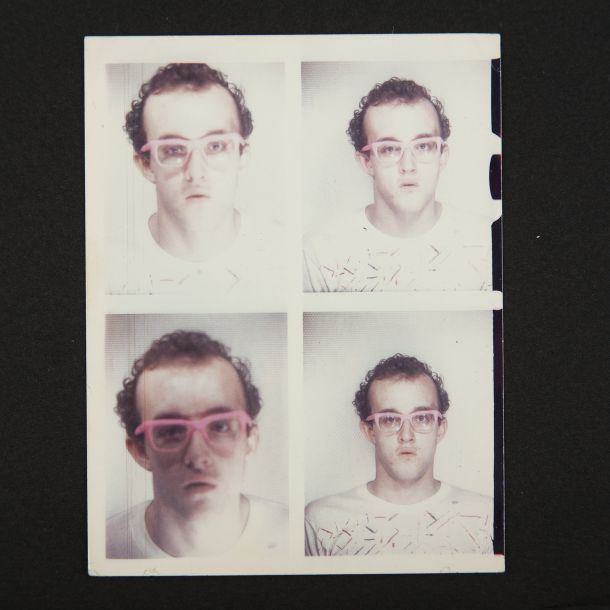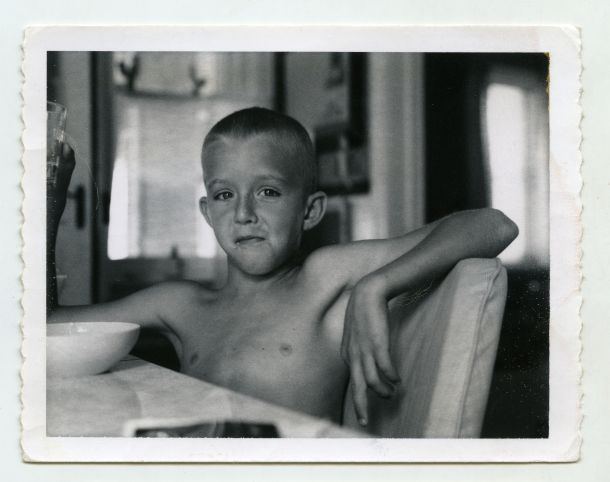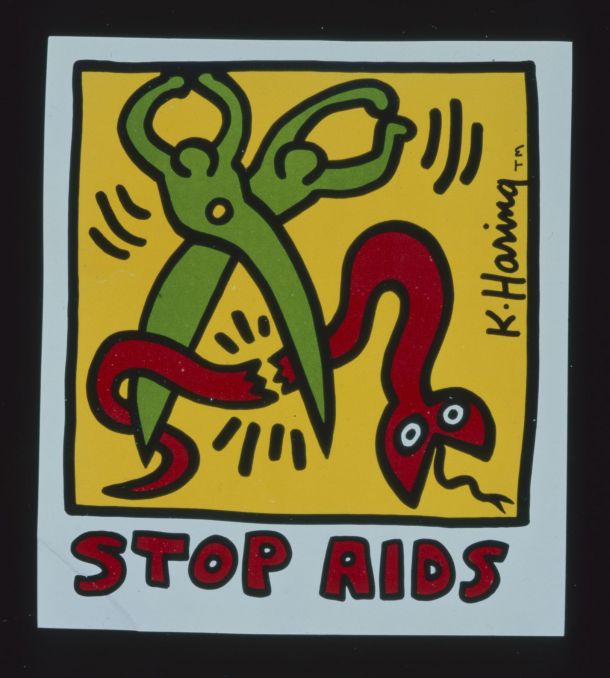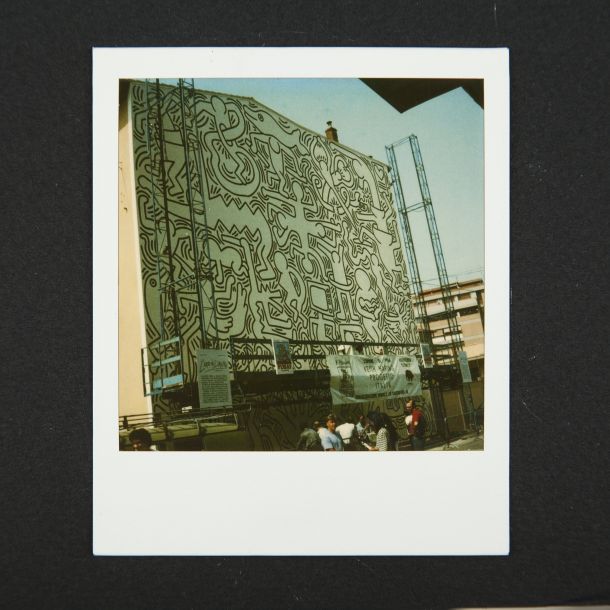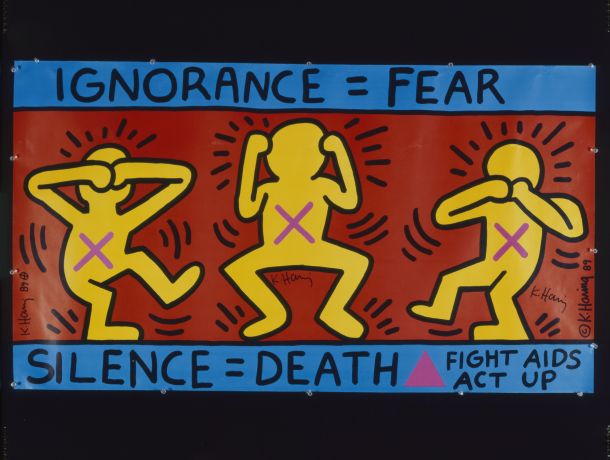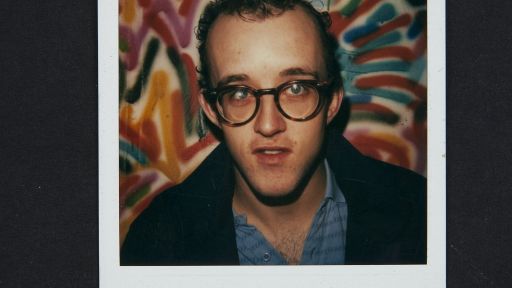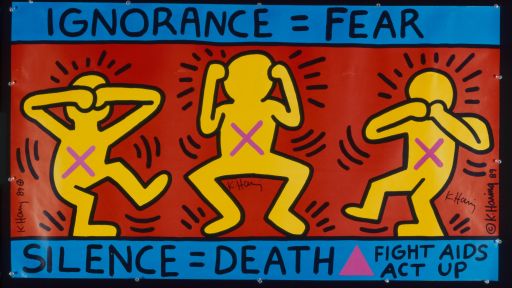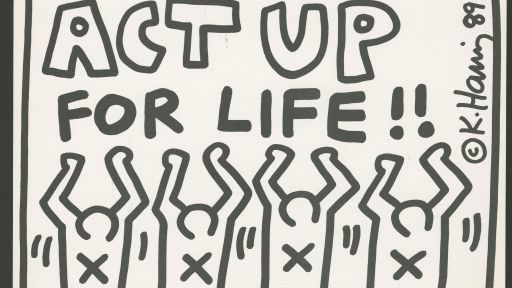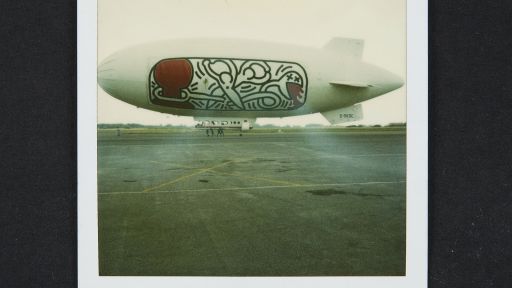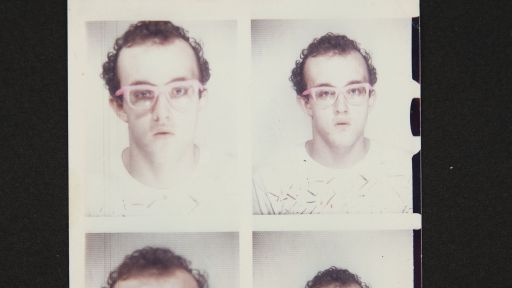Street artist. Prolific AIDS activist. Sexual art pioneer. Keith Haring was all of these things and so much more. In his 31 short years in this world, Haring saw more and achieved more than many. And his legacy — a collection of more than an estimated 10,000 pieces of art — lives on in commerce, culture, and the public imagination. But beyond the strong energetic lines and bold colors of his street art, which can still be seen in murals and billboards around the world today, who was the man behind the brush? Here are 10 little-known and controversial facts about the pop art prince, as told by his friends or Haring himself.
1) He grew up in a conservative town in rural Pennsylvania.
Haring was a self-described “nerd” growing up in the small, conservative town of Kutztown located in the heart of Pennsylvania Dutch country. But from a young age, Haring was already railing against the status quo and his straitlaced upbringings. He went to church camp every summer, where once, around the age of 12, he burst out of a cardboard cake and performed a strip tease dressed as a woman. While Haring’s parents did not exactly embrace the ’60s cultural revolution, they did kindle their son’s love of art, which was heavily inspired by the cartoons and animation of his childhood, including the work of Dr. Seuss and Walt Disney. “My father made cartoons. Since I was little, I had been doing cartoons, creating characters and stories. In my mind, though, there was a separation between cartooning and being an ‘artist,'” said Haring.
2) He was an activist from an early age
Around the time that Richard Nixon ran for president, a pre-teen Haring and his childhood friend, Kermit Oswald, began running around with bars of soap scribbling anti-Nixon slogans all over buildings in Kutztown, where ordinarily not a speck of graffiti could be seen. “People didn’t write on things that didn’t belong to them,” said Oswald.
3) His whole punk attitude was inspired by a scrap of paper
Talk about ambitious! At just 20 years old in 1978, Haring had his first solo art show at the Pittsburgh Arts and Crafts Center. One day, Haring was on his way to work when he noticed a piece of paper on the floor that read, “God is a dog.” He picked it up, and on the other side of the scrap was written, “Jesus is a Monkey.” Haring said of the experience, “I have no idea why this was like such a profound thing for me, but it triggered a punk attitude.” That same day, he cut his hair short and started buying punk records. Not long after that, Haring knew he had to move to New York City where he could find the intensity he wanted — both in his art and his life.
4) He was fascinated by semiotics
It was while studying at the School of Visual Arts (SVA) in New York City, that Haring first encountered semiotics, which he described as “looking at language and picking it apart and deciphering how meaning attached itself to things.” At this time, he found a stack of 13 glossy-printed letters and started rearranging them on his apartment wall into words. He kept rearranging those words to create new phrases and meanings. Around 1980, Haring began to make cut-ups from the New York Post. He rearranged them into provocative “new news” headlines in protest of Ronald Regan’s election, and posted them around town.
5) He was connected to one of the most infamous art vandals in history
Haring’s art dealer, Tony Shafrazi, was known as a larger-than-life figure who always said exactly what was on his mind. But before their formal partnership, Shafrazi made headlines when he strolled into New York’s Museum of Modern Art (MoMA) in 1974 and spray painted “Kill Lies All” in foot-high red letters across the famed Pablo Picasso painting “Guernica.” Through the public outrage at the time, Haring saw something in this rebellious act of vandalism. As he later said, “the fact [Shafrazi] believed in protests against the war and was committed enough to stand up to what he knew would be incredible attacks from the art world, I respected that.” In turn, Shafrazi became one of the first people to see the value in Haring’s work, helping Haring to turn his dreams of making money from art into a reality.
6) He wanted to bring art to the people, including the subways
During his art school years, Haring and his compatriots were starting to get bored of the art world as an elitist space. “It seemed like it was trying harder and harder to be more and more esoteric and not want to include the public at large,” said Haring’s friend and fellow SVA student Jimmy Scharf. Haring sought to rectify this by making art more accessible. Inspired by the graffiti he was seeing splashed on buildings and subway cars across the city, Haring began drawing on hundreds of empty black boards covering old advertisements in subway stations. He used chalk as his medium, stating that he didn’t want to appropriate the work of existing graffiti artists — especially those of color — by using spray paints. He loved the performative aspect of the drawing too, and spent lots of time interacting with subway commuters who wanted to chat about his work. It kicked off a lifetime of creating murals and art in public spaces that can still be seen around the world today.
7) Drugs influenced his art
As his career was soaring, Haring continued to party hard at nightclubs across New York. One of them was the Paradise Garage. Friend and roommate Drew Straub described the venue as a “big gay disco” that had the “greatest sound system ever known to man.” But since no alcohol was served there, many at the club took drugs instead, Straub said. For Haring, the drugs — particularly hallucinogens — fueled and inspired his work. “A lot of Keith’s ‘vibrations’ around everything that he drew was kind of psychedelic,” noted Straub.
8) At one point, he was pretty controversial Down Under
Although Haring was gaining global popularity, he wasn’t beloved everywhere. In 1984, Haring travelled to Australia where he painted a giant mural on the glass front of the National Gallery of Victoria. He was surprised when his work stirred up front page controversy and outrage from activists who felt he was appropriating indigenous Australian line drawings. “People there were seeing it as Aboriginal, but I was doing what I had been doing in New York and America and all over the world,” said Haring of the incident. About a month after he left Australia, a protester threw a shot put through the center glass panel, and the entire artwork was removed.
9) His friends threw shade at Madonna
View this post on Instagram
As soon as Haring’s art became known and celebrated around the world, the celebrities and party invitations followed. He was known for rubbing elbows with some of the hottest artists and stars of the time including Andy Warhol, Brooke Shields, and Boy George, which irked some of Haring’s oldest and closest friends who felt he was snubbing them for people he barely knew. But his closest friends particularly disliked one of his new buddies, a blonde and little-known singer (at the time) named Madonna. “They didn’t take to Madonna — it’s like ‘Who is this trashy white girl who can’t sing?'” recalled Straub.
10) He couldn’t get a major museum in the US to take him seriously
When Haring was 27, he was showing regularly at major museums around the world, but curators and critics in America were still seemingly snubbing his work. “We were like, ‘What the f—’s wrong with these American curators, how come they don’t get it?’ You know. He was combated by critics for having a style that resembled illustration, (but) you could say, he had to think about what he was illustrating. You know all the belief systems were being challenged,” said friend George Condo of the situation. MoMA was a particular bee in Haring’s bonnet. “Keith was very hurt that during the period when he was having his one-man shows all around the world, that MoMa wasn’t interested,” Staub recalled. After his death, Haring had numerous retrospective exhibits in art museums across the US, including MoMA, where select artworks are still being held to this day.
* All facts and quotes from “Keith Haring: Street Art Boy”
Keith Haring: Street Art Boy begins streaming December 4th at pbs.org/americanmasters and the PBS Video app

